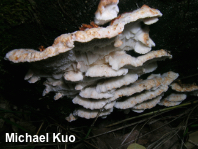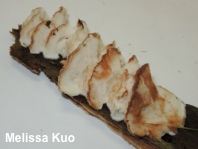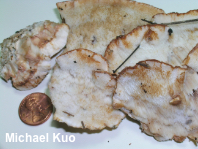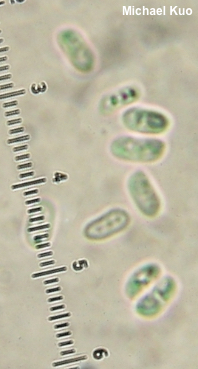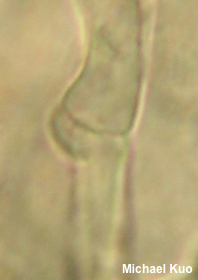| Major Groups > Polypores / Toothed Mushrooms > Fuscopostia fragilis |

|
Fuscopostia fragilis [ Basidiomycota > Polyporales > Fomitopsidaceae > Fuscopostia . . . ] by Michael Kuo Common on the deadwood of spruces and other conifers across Europe and North America, Fuscopostia fragilis can be recognized by its reddish brown-bruising cap and pore surface, and by the fact that the "pores" of this polypore often become elongated and tooth-like. Look-alikes may need to be separated with microscopic features; Parmastomyces mollissimus has dextrinoid (rather than inamyloid) spores, while Amylocystis lapponica features encrusted, amyloid cystidia. Tyromyces fragilis, Postia fragilis, and Oligoporus fragilis are among many synonyms. I am using the most current name for this fungus, but I note that the genus Fuscopostia was proposed (Shen et al. 2018) without following several of the guidelines for establishment of new genera as set forth in Vellinga et al. 2016; by the time you are reading this, a better taxonomic solution may have appeared. Thanks to Walt Sturgeon for teaching me this mushroom. Thanks to Charlotte Lukes for documenting, collecting, and preserving Fuscopostia fragilis for study; her collection is deposited in The Herbarium of Michael Kuo. Description: Ecology: Saprobic on the deadwood of spruces and other conifers; causing a brown rot; growing alone or gregariously; annual; spring through fall, or over winter in warm climates; originally described from Sweden; widely distributed in Europe and in North America. The illustrated and described collections are from Illinois, Ohio, and Wisconsin. Fruiting Body: Often producing a well-developed cap, but sometimes effused-reflexed, with only a few cap-like edges. Cap (when present): 2.5–12 cm across; up to 2 cm deep; irregularly rectangular, or vaguely semicircular in outline; planoconvex to flat; dry or a little moist; fuzzy to appressed-hairy; whitish at first, but soon staining and discoloring reddish brown to brown. Pore Surface: Whitish; bruising reddish brown to brown; with 4–5 angular pores per mm, especially near the margin—but the pores usually become lacerated and toothlike; tubes up to 15 mm deep. Stem: Absent. Flesh: White; unchanging when sliced; soft and pliable, becoming tougher with age. Odor and Taste: Odor fragrant, or not distinctive; taste not distinctive. Chemical Reactions: KOH negative on flesh; negative on cap surface; negative or slightly olive on pore surface. Spore Print: White. Microscopic Features: Spores 4–5 x 2–2.5 µm (but occasionally as large as 7 x 3 µm); allantoid to cylindric; smooth; hyaline in KOH; inamyloid. Basidia 15–18 x 4–5 µm; clavate; 4-sterigmate. Cystidia not found. Setae not found. Hyphal system monomitic; hyphae 2–6 µm wide, thin- or moderately thick-walled, smooth, hyaline to orange-brown in KOH, with conspicuous clamp connections. REFERENCES: (E. M. Fries, 1828) B. K. Cui, L. L. Shen & Y. C. Dai, 2018. (Overholts, 1953; Lowe, 1975; Arora, 1986; Breitenbach & Kränzlin, 1986; Gilbertson & Ryvarden, 1987; Phillips, 1991/2005; Lincoff, 1992; Barron, 1999; Roody, 2003; McNeil, 2006; Buczacki et al., 2013; Desjardin, Wood & Stevens, 2015; Siegel & Schwarz, 2016; Woehrel & Light, 2017; Læssøe & Petersen, 2019; Shen et al., 2019.) Herb. Kuo 10021202, 07181506, 10272101. This site contains no information about the edibility or toxicity of mushrooms. |
© MushroomExpert.Com |
|
Cite this page as: Kuo, M. (2022, May). Fuscopostia fragilis. Retrieved from the MushroomExpert.Com Web site: http://www.mushroomexpert.com/fuscopostia_fragilis.html |

